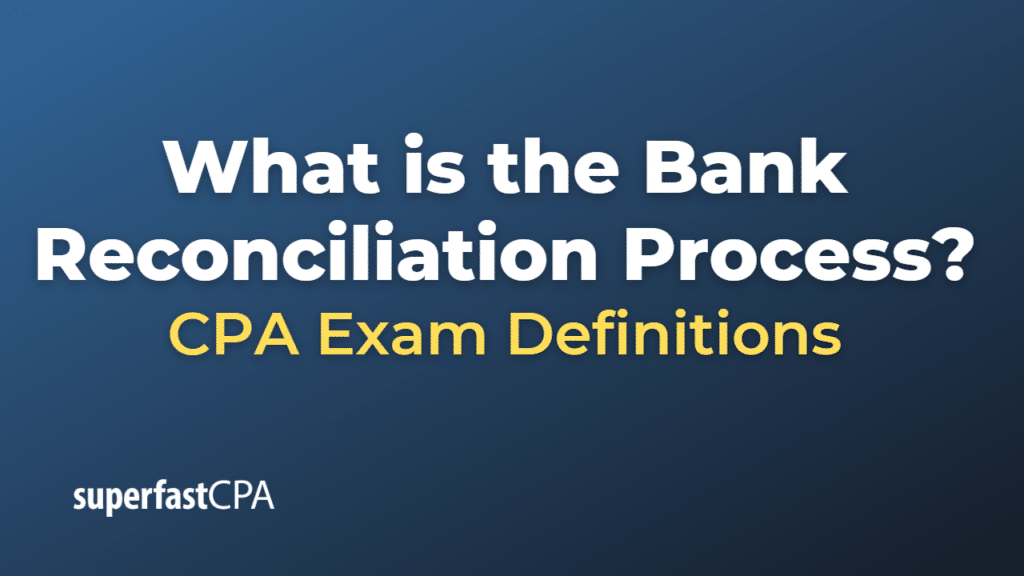Bank Reconciliation Process
The bank reconciliation process is a financial procedure that involves comparing a company’s or individual’s internal financial records with their bank statement to ensure accuracy, consistency, and completeness. The main goal of this process is to identify discrepancies, errors, unauthorized transactions, and to verify that all transactions have been correctly recorded and processed.
The bank reconciliation process typically involves the following steps:
- Obtain bank statement: Get the most recent bank statement for the account being reconciled. This statement usually includes the account balance, deposits, withdrawals, fees, and other transactions for a specific period (e.g., monthly).
- Gather internal financial records: Compile the internal financial records, such as the general ledger, cash book, or transaction register, for the same period as the bank statement.
- Compare records: Review and compare the internal financial records with the transactions listed on the bank statement. Identify any differences or discrepancies between the two sets of records.
- Identify discrepancies: Common discrepancies include outstanding checks, deposits in transit, bank errors, unauthorized transactions, or differences in recorded amounts. Make a list of these discrepancies for further investigation.
- Investigate and resolve discrepancies: Investigate the cause of each discrepancy and take appropriate action to correct errors or address unauthorized transactions. This may involve contacting the bank to report errors or fraud or updating the internal financial records to reflect the correct information.
- Adjust internal records: Update the internal financial records to account for any identified discrepancies, such as recording bank fees, correcting transaction amounts, or accounting for outstanding checks and deposits in transit.
- Prepare a reconciliation statement: Create a formal bank reconciliation statement or report that shows the reconciled account balance and any adjustments made during the process. This statement should clearly indicate the starting and ending balances of both the internal records and the bank statement, as well as any adjustments made to reconcile the two.
- Review and approval: Have a supervisor or another responsible party review and approve the completed bank reconciliation to ensure accuracy and proper oversight.
- Retain documentation: Keep a copy of the completed bank reconciliation statement and any supporting documentation (such as bank statements, transaction records, and correction notes) for future reference and auditing purposes.
By following the bank reconciliation process, businesses and individuals can maintain accurate financial records, identify potential errors or fraud, and ensure the security of their financial assets. This process also provides valuable information for financial planning and decision-making.
Example of the Bank Reconciliation Process
Let’s consider an example of a small business owner performing a monthly bank reconciliation process for their business checking account.
- Obtain bank statement: The business owner receives their bank statement for the month of August, which shows an ending balance of $10,000.
- Gather internal financial records: The business owner compiles their cash book (internal financial records) for the month of August and finds an ending balance of $9,700.
- Compare records: The business owner reviews and compares the transactions listed in the cash book with those on the bank statement, looking for any differences or discrepancies.
- Identify discrepancies: The business owner identifies the following discrepancies:
- A deposit of $800 made at the end of the month is recorded in the cash book but not yet reflected on the bank statement (deposit in transit).
- A check for $300 issued to a vendor is recorded in the cash book but has not yet cleared on the bank statement (outstanding check).
- A bank service fee of $200 is shown on the bank statement but not yet recorded in the cash book.
- Investigate and resolve discrepancies: The business owner verifies that the deposit in transit and the outstanding check are valid transactions that have not yet been processed by the bank. They also confirm that the bank service fee is accurate and should be recorded in the cash book.
- Adjust internal records: The business owner updates their cash book to account for the bank service fee:
- Cash book balance: $9,700
- Bank service fee: -$200
- Adjusted cash book balance: $9,500
- Prepare a reconciliation statement: The business owner prepares a bank reconciliation statement that shows the following:
- Bank statement balance: $10,000
- Deposit in transit: +$800
- Outstanding check: -$300
- Adjusted bank statement balance: $10,500
- Cash book balance: $9,700
- Bank service fee: -$200
- Adjusted cash book balance: $9,500
- Reconciliation difference: $10,500 (Adjusted bank statement balance) – $9,500 (Adjusted cash book balance) = $1,000
- Review and approval: The business owner asks their office manager to review and approve the completed bank reconciliation to ensure accuracy and proper oversight.
- Retain documentation: The business owner keeps a copy of the completed bank reconciliation statement, along with the bank statement, cash book records, and any notes related to the identified discrepancies, for future reference and auditing purposes.
In this example, the business owner has followed the bank reconciliation process to identify and resolve discrepancies between their internal financial records and the bank statement. This process helps ensure the accuracy of their financial records and provides valuable information for financial planning and decision-making.













